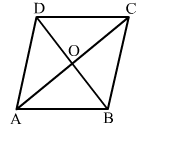Question:
In the given figure, ABCD is a rhombus. Then,
(a) $A C^{2}+B D^{2}=A B^{2}$
(b) $A C^{2}+B D^{2}=2 A B^{2}$
(c) $A C^{2}+B D^{2}=4 A B^{2}$
(d) $2\left(A C^{2}+B D^{2}\right)=3 A B^{2}$

Solution:
(c) $A C^{2}+B D^{2}=4 A B^{2}$
Explanation:
We know that the diagonals of a rhombus bisect each other at right angles.
Here, $O A=\frac{1}{2} A C, O B=\frac{1}{2} B D$ and $\angle A O B=90^{\circ}$
Now, $A B^{2}=O A^{2}+O B^{2}=\frac{1}{4}(A C)^{2}+\frac{1}{4}(B D)^{2}$
$\therefore 4 A B^{2}=\left(A C^{2}+B D^{2}\right)$
Click here to get exam-ready with eSaral
For making your preparation journey smoother of JEE, NEET and Class 8 to 10, grab our app now.
